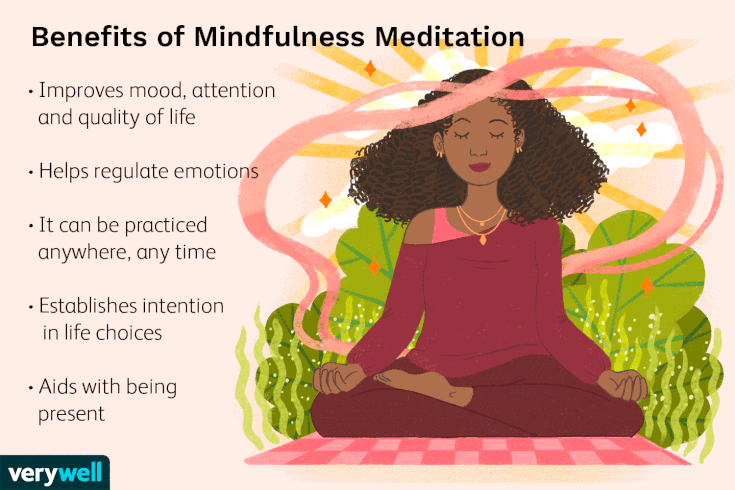
Meditation has been called religious or secular depending on how one defines it. It was originally used to describe religious practices, but it is now widely used in a second sense. Meditation is often misunderstood. Here are some facts to help you understand meditation. Here are some thoughts to help you determine if meditation can be considered religious. Meditation is often viewed as a form or worship. This is false. The practice is nonreligious and is suitable for anyone.
Meditation can take many forms. Many of these meditations have religious roots, although not all are accepted by all faiths. Early Christian practices rely on repeated prayer and synchronized breathing. The icons are the focus of meditation in Eastern Orthodox and Jesuit traditions. Buddhist and Western medical doctors also use imagery, imagination, and other methods to comprehend the teachings and messages of Christ. Whatever form of meditation it may be, it's considered religious. If you aren't sure, you can read a book and look online to learn more.

There is no connection between meditation and Buddhism. It is a mental exercise that benefits the brain, and not a religious practice. Nevertheless, it has been a popular activity for centuries. It can help strengthen the mind, which is vital for its development. There are many different types of meditation. Each type serves a purpose. Regardless of its origin, the practice of meditation is a powerful tool for mental health.
Some people believe that meditation is a form of prayer. It is possible to define prayer differently depending on how it is practiced. Most prayer involves dialogue and an appeal to the divine entity. But there's a much more extensive definition of prayer. It involves shaping the mind and cultivating qualities such as immeasurable love. Meditation is often referred to as a religion. It is important that you know the difference between meditation or prayer. Meditation is still a great technique for healing, clearing your thoughts, and attaining insight.
Meditation is a process that differs for everyone. Although meditation is not considered religious, it can be used in spiritual settings. It can help people concentrate on a certain thought. It can be used to achieve a peaceful mind. You can use it to focus on a particular object or flower. It is a powerful technique to help you accomplish this goal.

Meditation is not a religion. It is a tool for transformation that can be used for many purposes. Meditation is not only a way to express yourself, but it is also grounded in a good set values. Meditation is a way to make your life better, be more balanced, and bring joy to others. It doesn't have to be this way if you don't want it.
FAQ
How much should I weigh for my height and age? BMI calculator & chart
Use a BMI calculator to determine how much weight is needed to lose. A healthy BMI range is between 18.5 and 24.9. To lose weight, you should aim for a loss of 10 pounds per year. To calculate your BMI, simply enter your height and weight into the BMI calculator.
This BMI chart can help you find out if or not you are obese.
What is the most healthful lifestyle?
Healthy lifestyles include eating healthy food, regular exercise, good sleep, and avoiding stress. These guidelines will help you live a long, healthy life.
You can start by making small changes in your diet and exercise routine. You can lose weight by walking 30 minutes each day if you are looking to lose weight. If you're looking for a way to increase your activity, consider taking up swimming or dancing. You could also sign up to an online fitness platform like Strava, which tracks your activity.
Improve immunity with herbs and supplements?
To boost immunity function, herbs and natural remedies are available. Some common examples include garlic, ginger, oregano oil, echinacea, ginkgo biloba, and vitamin C.
These herbal remedies should not be used in place of conventional medical treatment. These herbal remedies can cause nausea, vomiting, stomach cramps or dizziness.
What should my diet consist of?
You should eat lots of vegetables and fruits. These fruits and vegetables are high in vitamins, minerals, which can help you keep your immune systems strong. They are also rich in fiber, which is good for digestion and makes fruits and vegetables filling. Include at least five portions of fruit and vegetables per day.
Make sure you drink plenty of water too. Water flushes toxins out of the body and helps to feel full between meals. Drink about eight glasses each day.
Whole grains are better than refined ones. Whole grains are rich in nutrients such as iron, zinc and magnesium. Refined grains lack some nutrition.
Sugary drinks are best avoided. Sugary drinks have empty calories and are a major contributor to obesity. Instead, drink water, milk, or unsweetened Tea.
Avoid fast food. Fast food lacks nutritional value. Although it may taste delicious, fast food won't provide you with the energy you need for your daily activities. Avoid soups, sandwiches and other unhealthy options.
Limit your alcohol consumption. Alcohol contains empty calories and contributes to poor nutrition. Limit your intake of alcohol to two drinks per week.
Red meats should be avoided. Red meats contain high amounts of saturated fats and cholesterol. Lean cuts of beef or pork, lamb and chicken, as well as fish, are better choices.
Statistics
- This article received 11 testimonials and 86% of readers who voted found it helpful, earning it our reader-approved status. (wikihow.com)
- WHO recommends reducing saturated fats to less than 10% of total energy intake; reducing trans-fats to less than 1% of total energy intake; and replacing both saturated fats and trans-fats to unsaturated fats. (who.int)
- In both adults and children, the intake of free sugars should be reduced to less than 10% of total energy intake. (who.int)
- nutrients.[17]X Research sourceWhole grains to try include: 100% whole wheat pasta and bread, brown rice, whole grain oats, farro, millet, quinoa, and barley. (wikihow.com)
External Links
How To
What does the term "vitamins" mean?
Vitamins are organic compounds that can be found in foods. Vitamins are essential for our bodies to absorb nutrients from the foods we eat. Vitamins cannot come from the body so food must provide them.
There are two types of vitamins: water soluble and fat soluble. Water-soluble vitamins dissolve readily in water. Examples include vitamin C,B1 (thiamine), B2 (riboflavin), B3 (niacin), B6 (pyridoxine), folic acid, biotin, pantothenic acid, and choline. The liver and fat soluble vitamins are stored within the liver and in fatty tissue. Some examples include vitamin D and E, K, A and beta carotene.
Vitamins are classified according to their biological activity. There are eight major vitamin groups:
-
A - essential for normal growth and maintenance of health.
-
C - important for proper nerve function and energy production.
-
D - essential for healthy bones, teeth, and gums.
-
E - Required for good vision & reproduction
-
K - required for healthy muscles and nerves.
-
P - essential for strong bones, teeth and tendons
-
Q - Aids digestion and iron absorption
-
R is required for the production of red blood cells.
The recommended daily allowance (RDA) of vitamins varies depending on age, gender, and physical condition. The U.S. Food and Drug Administration sets RDA values.
For adults aged 19 and older, the RDA for vitamin B is 400 micrograms daily. For fetal development, pregnant women need 600 mg per day. Children ages 1-8 require 900 micrograms per day. Infants under one year of age require 700 micrograms per day, but this amount decreases to 500 micrograms per day between 9 months and 12 months of age.
Children aged between 1-18 years require 800 micrograms of sugar per day, while overweight children need 1000 micrograms. Children who are underweight receive 1200 micrograms every day to meet their nutritional requirements.
Children between 4 and 8 years old with anemia will need 2200 micrograms daily of vitamin C.
2000 micrograms is the minimum daily intake for adults over 50 years old to maintain good health. Women who are pregnant or breastfeeding need 3000 micrograms per day due to increased nutrient requirements.
1500 micrograms are required daily by adults over 70 because they lose approximately 10% of their muscle each decade.
Women who are pregnant or nursing need more than the RDA. Pregnant woman need 4000 micrograms daily in pregnancy, and 2500 per day after childbirth. Breastfeeding mothers require 5000 micrograms daily when breast milk production is occurring.